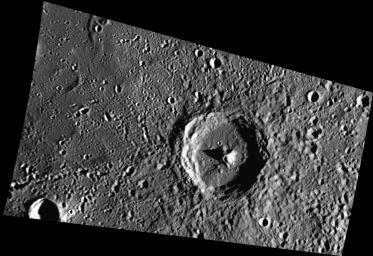Originally released on Oct. 9, 2013
Today's image introduces crater Kosho, which sits in Mercury's northern hemisphere. Kosho, 65 km (~40 mi.) in diameter, is a complex crater. The long shadows in this image accentuate Kosho's central peak, which is approximately 2 km (~1.2 mi.) high. Kosho crater is named for a thirteenth century Japanese sculptor famous for his depictions of Buddhist Monks.
This image was acquired as part of MDIS's minimum-phase-angle color campaign. Near the north polar region, the incidence angle (measured from the vertical) is always fairly high because the Sun is low on the horizon. The minimum-phase-angle color campaign acquires images under conditions that minimize the shadows in an image by viewing the surface as nearly as possible from the same direction as the Sun's illumination, which minimizes the phase angle. Images are acquired through five of the WAC's narrow-band color filters, for regions north of 60° N, at an average resolution of 500 meters/pixel. The minimum-phase-angle color campaign began in March 2013.
Date acquired: September 17, 2013
Image Mission Elapsed Time (MET): 21703926
Image ID: 4836915
Instrument: Wide Angle Camera (WAC) of the Mercury Dual Imaging System (MDIS)
WAC filter: 7 (748 nanometers)
Center Latitude: 60.01°
Center Longitude: 220.2° E
Resolution: 269 meters/pixel
Scale:Kosho crater is approximately 65 km (40 mi.) in diameter
Incidence Angle: 83.3°
Emission Angle: 55.3°
Phase Angle: 28.0°
The MESSENGER spacecraft is the first ever to orbit the planet Mercury, and the spacecraft's seven scientific instruments and radio science investigation are unraveling the history and evolution of the Solar System's innermost planet. MESSENGER acquired over 150,000 images and extensive other data sets. MESSENGER is capable of continuing orbital operations until early 2015.
For information regarding the use of images, see the MESSENGER image use policy.

 Planetary Data System
Planetary Data System












